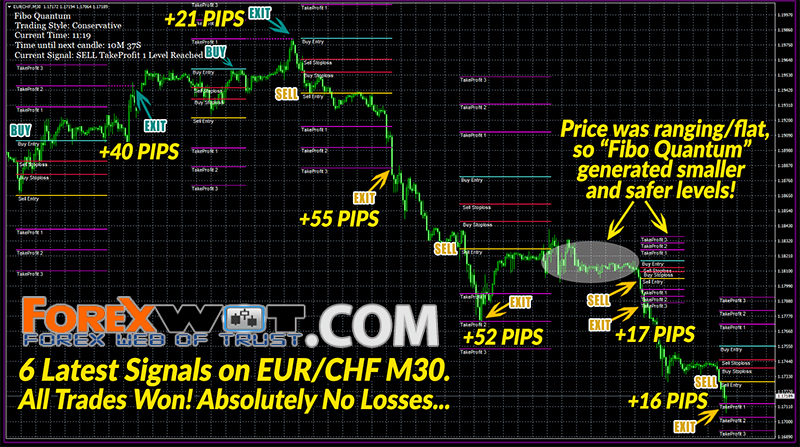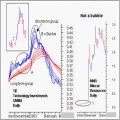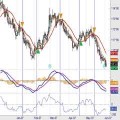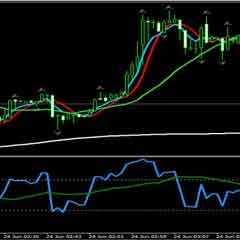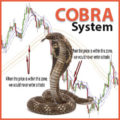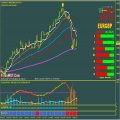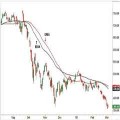The Benefits of Using Moving Averages – Spotting Trend Changes and Trading Signals.
Price movements of all actively traded securities are a measure of volatility and therefore take on the appearance of being very erratic.

To the untrained eye, the price chart of any given security resembles an indecipherable mess of squiggly lines with little meaning.
Even to an experienced chart analyst price fluctuations can be very misleading.
What is called for in order to eliminate these wild undulations and to enable the analyst to identify the underlying trend is a smoothing device, something to reduce the undulations and isolate the overall movement of prices.
This is the function best served by moving averages.
All averages of prices tend to fluctuate less actively than the prices from which they are derived:
The greater the number of days from which an average is composed, the more gentle and gradual are the fluctuations relative to the price action from which it is derived.
In his book, Commodity Futures Trading With Moving Averages, J.R. Maxwell provides a succinct account of the usefulness of moving averages when incorporated in a trading program:
The use of an average eliminates or reduces the distraction caused by the often sudden and relatively far-reaching daily price fluctuations, enabling the user to observe a smoother depiction of the trend changes as they occur.
This is one of the two principal reasons for the widespread use of various types of averages as trading tools.
The second principal reason is that these figures, when plotted as lines on charts, with the closing prices or other lines representing price action, will cross above and below one another as market trends change.
Two averages encompassing different numbers of price units (days) will cross over and under each other in the same fashion.
Such crossings, either by themselves or in combination with other signals, such as changes in statistical data concerning supply and demand, serve as trading signals for a large proportion of the people who speculate in the futures markets.
The Most Recommended Moving Averages Forex Trading Systems
- A Winning Strategy Using Moving Averages Forex Trading System
- Simple Profitable Forex Exponential Moving Average (EMA) Trading Strategy
- Advanced Moving Average Stupidly Simple Forex System
These crossings are definite, easily observed signals in a fast-moving and frequently very confusing swirl of activity.
Clear-cut signs, such as these are, to buy and to sell, can be comforting to have under such conditions, especially when they appear to be well accepted by so many traders, and their use seems to be based upon solid logic.
The different forms of analysis involving moving averages are many and varied.
Many traders place heavy emphasis on the trading signals provided when two moving averages of the underlying security’s Priceline cross.
Others rely on a system involving a moving average or series of moving averages calculated from a moving average itself in relation to the underlying security’s price to generate trading signals.
Others still prefer to rely simply on a single moving average, which is plotted with the Priceline.
The results they obtain trading with these signals vary depending on the time frame of the averages used along with a variety of other factors.
Concludes Maxwell: “A moving average is like any tool. It is essential to know its capabilities and its limitations before its potential value can be determined. Then, if it has any merit, the skill may be required to obtain the maximum benefit from its use.”
For a more detailed discussion of moving average crossovers, please see The Essence of Moving Averages: What Every Successful Forex Trader Should Know.
Trading systems based on fast moving averages are quite easy to follow.
Let’s take a look at this simple system.
- Currency pairs: ANY
- Timeframe chart: 1 hour or 15-minute chart
- Indicators: 10 EMA, 25 EMA, 50 EMA
Entry Rules:
When 10 EMA goes through 25 EMA and continues through 50 EMA, BUY/SELL in the direction of 10 EMA once it clearly makes it through 50 EMA.
(Just wait for the current price bar to close on the opposite side of 50 EMA. This waiting helps to avoid false signals).
Exit Rules:
- option 1: exit when 10 EMA crosses 25 EMA again.
- option 2: exit when 10 EMA returns and touches 50 EMA (again it is suggested to wait until the current price bar after so-called “touch” has been closed on the opposite side of 50 EMA).
Advantages:
it is easy to use, and it gives very good results when the market is trending, at big price break-outs and big price moves.

Disadvantages:
the Fast moving average indicator is a follow-up indicator or it is also called a lagging indicator, which means it does not predict future market directions, but rather reflects current situation on the market.
This characteristic makes it vulnerable: firstly, because it can change its signals anytime, secondly – because need to watch it all the time; and finally, when market trades sideways (no trend) with very little fluctuation in price it can give many false signals, so it is not suggested to use it during such periods.

